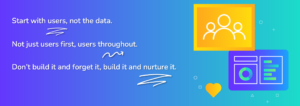A video replay for this webinar is available at the bottom of the blog.
In this webinar, we go over how to think like a consultant to elevate your dashboarding experience into something enjoyable for both devs and users alike.
The Three Principles
There are three cornerstones of the UCDD development philosophy that will be referenced later on:

You can also think of this as, “users first, users during and users after” for a more time-oriented approach.
Start with Users, not the Data
As consultants, we see a number of different data projects come to us in various states of effectiveness. Sometimes, they’re easy fix-type situations, and sometimes, they require a complete overhaul to be effective. In a situation like the latter, it’s easy to start brainstorming about what the end user might want immediately upon seeing the difficult to read dashboard. Instead, talking directly to the users about their use cases for the dashboard rather than just speculating is a good way to gain actionable information on how to proceed.
Instead of the standard reading the data, finding the story and making some charts, starting by having the user tell you the story gives valuable insights into how it’ll be used and avoids creating something that the users will never use.
Our job as consultants is to get the clients to step back, think like a product manager and spend more time in the identifying-the-problem space with their users before we jump to any kind of conclusions about what kind of dashboard to build.
Not Just Users First, Users Throughout
There’s plenty of way to keep your users in mind throughout the development process. Below, we’ve outlined a quick step-by-step of some bonus thoughts that can help:
- Keep your MVP in mind. And no, it’s not your Most Valuable Player.
- Defining a Minimum Viable Product is a quick way to get a draft of a dashboard into your users’ hands to playtest what works and what doesn’t. That constant communication helps refine the prototype dashboard into something they’d actually use.
- Rapid Prototyping
- Wireframing or working on your MVP in Tableau gets you feedback. Instead of creating a pixel-perfect prototype before showing it to anyone, potentially sending you right back to the drawing board, creating a quick and dirty version of your draft can let you specifically test individual pieces of your dashboard with the userbase.
- User Feedback
- After defining the MVP and rapid prototyping, applying that user feedback to future iterations keeps the process going effectively toward a usable product.
- Don’t change the user. Change the Design.
- If something doesn’t feel intuitive for a user in a user feedback session, it’s tempting to say that it’s a training issue or that you can just add instructions. Consider this: if you have to spend a minute teaching a single user how to use your product, how much time would that be when multiplied across every user?
Don’t Just Build it and Forget it, Build it and Nurture it
Our collaboration with users doesn’t end when we publish our dashboards. If we truly want to shift our mindset on dashboard development, then we need to think of dashboards with products with ongoing lifecycles that can be improved over time.
This is where it’s key to change from a developer mindset to a product manager mindset.
The best way to do this is to have a designated way for users to submit feedback in a regular, organized manner that allows developers to create a product roadmap of needed changes to come.
Curator by InterWorks, for instance, now has a “Dashboard Feedback” collection option that embeds a direct line from user to developer right into the dashboard itself. Eventually, it will evolve into using natural language processing to process that feedback and to create an insights dashboards.
The Workshop
If some of these ideas have been helpful to you, we have good news: we’re starting the User Centered Dashboard Development Workshop, where we’ll walk you and your team through these concepts with hands on, specialized training to promote a UCDD mindset.
The UCDD Workshop is an eight hour curriculum with seven modules of content that help you connect with your users, work with them and manage your products, all actionable the same day. For more information about the UCDD Workshop discussed in the webinar download our info sheet or reach out to our team for booking.
If you want to dive deeper into this concept, our webinar replay is listed below. If you’re wanting to browse future webinars or sign up for content that interests you, you’ll find all of that on our webinar page.

